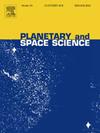Coupled mineralogical and nano-mechanical characterization of calcium sulfate veins in Martian analog rocks: Implications for Mars sample return drilling strategies
IF 1.7
4区 物理与天体物理
Q3 ASTRONOMY & ASTROPHYSICS
引用次数: 0
Abstract
Mars sample collection is often hindered by the mechanical fragility of calcium sulfate-filled fractures, which are prone to fragmentation under drilling-induced stress. This study presents a coupled mineralogical and nano-mechanical investigation of such fracture systems in terrestrial Martian analog rocks, aiming to inform Mars Sample Return (MSR) drilling strategies. X-ray diffraction (XRD), scanning electron microscopy in backscattered mode (SEM-BSE), and energy-dispersive spectroscopy (EDS) reveal that gypsum is the dominant fracture-filling phase, exhibiting spatial continuity but considerable heterogeneity at vein–matrix interfaces. The host matrix consists primarily of quartz, albite, and dolomite, creating stark mineralogical contrasts that control fracture evolution and mechanical response. Nano-indentation testing was conducted across gypsum, matrix, and interfacial regions, revealing significant differences in mechanical properties. Gypsum zones show pronounced plasticity and low elastic modulus (E ≈ 10–20 GPa), while matrix minerals such as quartz exhibit higher stiffness (E > 100 GPa) and hardness. Critically, vein–matrix interfaces display intermediate properties and increased indentation depths, indicating weak interfacial bonding and stress localization. These mechanically vulnerable zones are likely to fracture or delaminate during coring operations. By integrating mineralogical heterogeneity with mechanical behavior, this study identifies key failure mechanisms in sulfate-rich terrains and formulates drilling and coring recommendations tailored to mitigate damage. The findings provide essential guidance for tool design, load control strategies, and sample targeting, ultimately improving the reliability of core recovery and scientific return in future Mars exploration missions.
火星模拟岩石中硫酸钙脉的耦合矿物学和纳米力学表征:对火星样品返回钻探策略的影响
火星样品的采集常常受到硫酸钙填充裂缝的机械脆弱性的阻碍,这些裂缝在钻井引起的应力下容易破裂。本研究提出了地球火星模拟岩石中此类裂缝系统的矿物学和纳米力学耦合研究,旨在为火星样品返回(MSR)钻井策略提供信息。x射线衍射(XRD)、背散射扫描电镜(SEM-BSE)和能谱分析(EDS)表明,石膏是主要的裂缝充填相,在空间上具有连续性,但在脉基界面上具有较大的非均质性。寄主基质主要由石英、钠长石和白云岩组成,形成鲜明的矿物学对比,控制着裂缝演化和力学响应。在石膏、基体和界面区域进行了纳米压痕测试,揭示了力学性能的显著差异。石膏带表现出明显的塑性和低弹性模量(E≈10 ~ 20 GPa),而石英等基质矿物表现出较高的刚度(E > 100 GPa)和硬度。关键是,脉-基质界面表现出中等性质,压痕深度增加,表明界面结合和应力局部化较弱。在取心作业中,这些机械上脆弱的区域很可能破裂或分层。通过将矿物学非均质性与力学行为相结合,该研究确定了富硫酸盐地层的关键破坏机制,并制定了钻井和取心建议,以减轻损害。这些发现为工具设计、载荷控制策略和样品定位提供了重要指导,最终提高了未来火星探测任务中岩心回收和科学回报的可靠性。
本文章由计算机程序翻译,如有差异,请以英文原文为准。
求助全文
约1分钟内获得全文
求助全文
来源期刊

Planetary and Space Science
地学天文-天文与天体物理
CiteScore
5.40
自引率
4.20%
发文量
126
审稿时长
15 weeks
期刊介绍:
Planetary and Space Science publishes original articles as well as short communications (letters). Ground-based and space-borne instrumentation and laboratory simulation of solar system processes are included. The following fields of planetary and solar system research are covered:
• Celestial mechanics, including dynamical evolution of the solar system, gravitational captures and resonances, relativistic effects, tracking and dynamics
• Cosmochemistry and origin, including all aspects of the formation and initial physical and chemical evolution of the solar system
• Terrestrial planets and satellites, including the physics of the interiors, geology and morphology of the surfaces, tectonics, mineralogy and dating
• Outer planets and satellites, including formation and evolution, remote sensing at all wavelengths and in situ measurements
• Planetary atmospheres, including formation and evolution, circulation and meteorology, boundary layers, remote sensing and laboratory simulation
• Planetary magnetospheres and ionospheres, including origin of magnetic fields, magnetospheric plasma and radiation belts, and their interaction with the sun, the solar wind and satellites
• Small bodies, dust and rings, including asteroids, comets and zodiacal light and their interaction with the solar radiation and the solar wind
• Exobiology, including origin of life, detection of planetary ecosystems and pre-biological phenomena in the solar system and laboratory simulations
• Extrasolar systems, including the detection and/or the detectability of exoplanets and planetary systems, their formation and evolution, the physical and chemical properties of the exoplanets
• History of planetary and space research
 求助内容:
求助内容: 应助结果提醒方式:
应助结果提醒方式:


